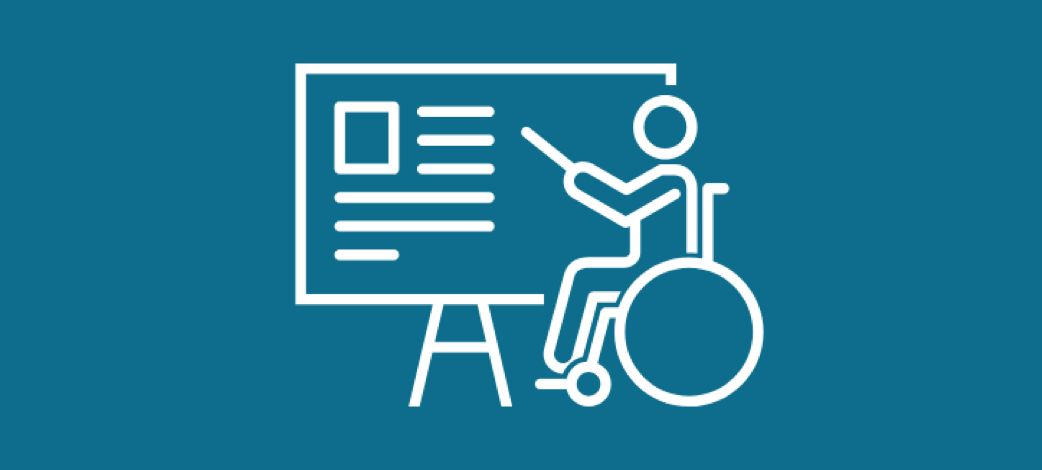#BeExcellent: Event Planning with Universal Design: What to Do Before, During & After
Tips and Tools | Accessibility | Arts And Culture | Event Planning
Back in the fall, we started this #BeExcellent blog series to provide tips to help artists engage more mindfully with all members of our communities. We’re back today with a primer on event planning using universal design thinking.
What is “universal design?”
Universal design is a guiding principle that anything we design should be usable and accessible to all people, regardless of age, ability or disability, or any other life factors. I particularly love the description of universal design from this guide from the HBCU Disability Consortium’s Black, Disabled, and Proud site:
Universal design asks people to think about the “universe” of users, and to design something that will be as welcoming and engaging as possible beginning at the early planning stages (just like planning to have an elevator right away instead of trying to add one to a building later).
The concept of universal design was originally developed with the intention to break down barriers to physical accessibility for people with disabilities in the built environment as well as to make products more accessible for users with disabilities. For example, dropped curbs were introduced on street corners to help wheelchair users and others navigate streets and sidewalks, and assistive technologies are integrated in the iPhone for all users and can make the product more usable for people with disabilities, such as screen navigation tools for people who are blind or have low vision. While this is the obvious domain of architects, industrial designers, and web developers, this concept can be meaningfully extended to all kinds of work and is intrinsically relevant to artists. Why? Because your goal as an artist is to reach people with your artwork. Engaging in universal design thinking can help you ensure that your work can be experienced by more members of your community regardless of life factors that may limit their experience in many other spaces.
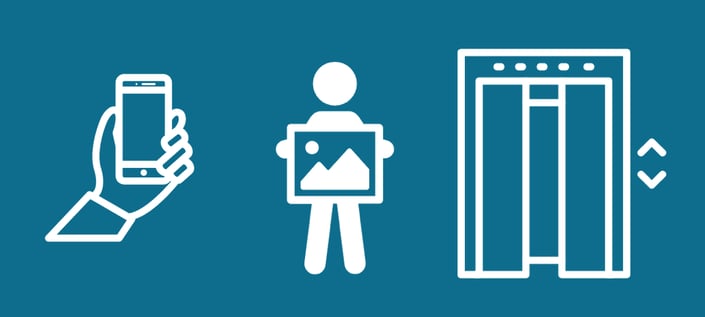
With this goal in mind, I’m going to frame the decision-making process we all engage when organizing in-person arts events, broken down by some choices we can make before, during, and after to make our work more accessible and inclusive.
Before we go any further, I want to offer a quick note about me, the author: I’m not an expert. You’ll notice that where I lack first-hand experience, I will always link to resources and knowledge generated and compiled by others, and provide credit where credit is due. This guide is truly a primer, and it is by no means exhaustive. I’m learning all the time, and I’ve looked to the work and knowledge of others to craft this blog post. So this post (and any other post I may write in this series) is a way to encourage other artists without first-hand experience to share in my learning process, with open recognition that we all come from different experiences and levels of familiarity with any given topic touched upon here.
That said, let’s get into some suggestions for how to engage universal design thinking when organizing your event from start to finish.
What to do before your event:
- Start by asking yourself questions. Who are the people in my audience? What are their needs? Avoid making assumptions about your audience members as people and challenge yourself to consider potential needs that you may not already be aware of. Honestly consider what potential audience members may not have been able to experience your work as presented in past events or who may not have felt included or welcome to attend.
- Choose a location thoughtfully. If you can, secure a physical space that is at least ADA-compliant and easily accessible by public transportation. When exploring your options consider and try to anticipate any mobility barriers or other limitations. Look for venues with all-gender restrooms that will meet a variety of mobility needs or have at least one restroom that meets both these criteria. If you are presenting out of your own space, consider implementing mobility accommodations to make your space more accessible for wheelchair users, walker users, cane users, and others.
- If you need to charge for entry, consider offering admission on a sliding scale. Sliding scale admissions can help alleviate cost barriers for lower-income and fixed-income attendees.
- Create an invitation/event announcement with key information. Tell your audience members what they need to know. This includes, not only the what, where, and when of your event, but also essential accessibility information (see points below), price of admission, transportation options, childcare availability, and any other information that would help inform individuals about the event’s content and accommodations. In creating these materials, also be sure that this information is public and accessible, including to people who use screen readers and other assistive technology.
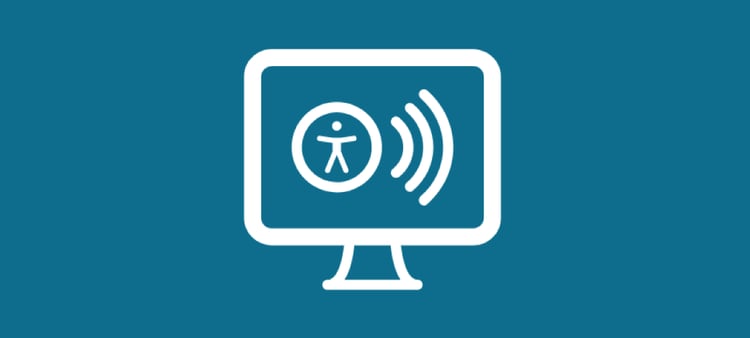 Desktop screen with symbols representing web accessibility and screen readers
Desktop screen with symbols representing web accessibility and screen readers
- Include notes on accessibility wherever you publicize your event. Be consistent in providing your audience the information they need to know to access your event. Be honest and transparent about what accessibility needs you can and cannot accommodate where applicable, and indicate that audiences can contact you about any accommodation needs they may have. If there are steps, stairs, or other potential obstacles to entry, be as specific as you can in providing that information upfront. If referring to the needs of people with disabilities or any other groups of people, be conscientious and respectful in the language you choose. A Progressive’s Style Guide offers some useful guidance on language, including discussion of terms to be avoided in favor of other language. That said, language around identity and experience is constantly evolving, and it’s important to create space and respond to the language preferred by the people and communities in your audience.
- Designate a specific point person on your team who can be contacted for access needs. Post their contact info (including both a phone number and email address so they can be contacted by people with different accessibility needs) in all places where you’re promoting your event.
- Meet with your team in advance of the event. Ensure that all members of your team (including any volunteers helping out) are prepared to assist members of your audience to meet their accessibility and any other needs. Make your team aware not only of accommodations in the event space, but also be sure folks are informed of basic disability etiquette and able to practice general courtesy when engaging with people from backgrounds and experiences that may differ from their own. If you haven’t already, research local resources to arrange for a disability awareness training for your team.
What to do during your event:
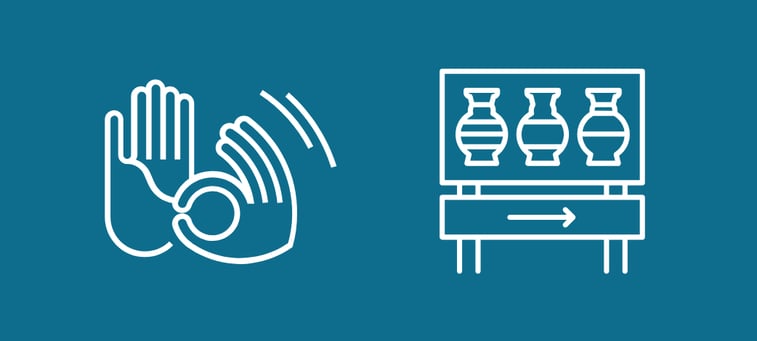 Two hands signing in ASL and signage with directions to an exhibit
Two hands signing in ASL and signage with directions to an exhibit
- Make text information accessible in multiple ways. If you have printed programs, signage, or wall texts, be sure that all (or at least key) information provided in any printed text is also presented verbally or is otherwise accessible to people with disabilities (see point below). Whenever possible, also consider making your event multilingual to reflect the language diversity of your local community. For instance, if you are producing an event in the United States, you may make all text bilingual and integrate Spanish language translation during the event, to increase access for a significant portion of the U.S. population who are Spanish-speaking.
- If you can, provide American Sign Language (ASL) interpretation, audio description, and/or Communication Access Real-time Translation (CART). Audio description can help people who are blind or have low-vision experience visual content in your work through narrated descriptions, while ASL interpretation and CART (a speech-to-text captioning system) can increase access for people who are deaf or hard of hearing. Keep in mind that offering both ASL and CART may be critical as not all people who are deaf or hard of hearing speak ASL. Captions can also be helpful to people whose primary language is not English and people who process visual information more comfortably than speech.
- Provide content/trigger warnings as needed. Communicate verbally and/or in signage/program text a general idea of what type of content is included in the work that could potentially trigger an individual’s experience of trauma. Content warnings keep audience members with Post-Traumatic Stress Disorder and other conditions and histories informed so they can better make decisions about how they choose to experience the work. A trigger warning should also be provided if your work includes any special effects (i.e. strobe lights, loud sounds, fog, etc.).
- If you can, live stream your event or record video that can be experienced online. Live streaming and video documentation posted online makes your work accessible to audiences who cannot leave their homes for the event or otherwise unable to attend for a wide range of reasons and can help your work reach people outside of your immediate geographic area.
What to do after your event:
- Send out a post-event survey. In that survey, include relevant questions about accessibility. Encourage honest feedback, and show that you’re open to making better decisions in the future as needed. However you choose to solicit feedback, be sure that online survey forms are accessible and/or that audience members can provide feedback to you in different ways (e.g. verbally in-person or by phone, over email, etc.). If pain points are identified, make a plan to do better next time and continue your learning. Thank individuals for their feedback and apologize for any mistakes.
- Use alt-text and captions in your online media. Are you sharing documentation of your event on your website or social media? Include alt-text and title/caption any photos you share online. If you’re posting a video, make sure to include captions.
- Reflect and ask yourself more questions. Do you know of anyone who was unable to attend? Is it possible that you’re not aware of others who were not able to attend? What might have hindered their participation? Did your venue present any unforeseen barriers to access you didn’t anticipate? How can you prepare for your next event to mitigate those barriers?
- Account for accessibility costs in your future budgets. Factor in capital improvements that will improve accessibility and any costs associated with accessibility accommodations when creating your project and/or yearly organization budgets. When applying for grants, include accessibility as a line item in your expenses and indicate to your funders that these costs are essential to your programs.
Finally, keep learning.
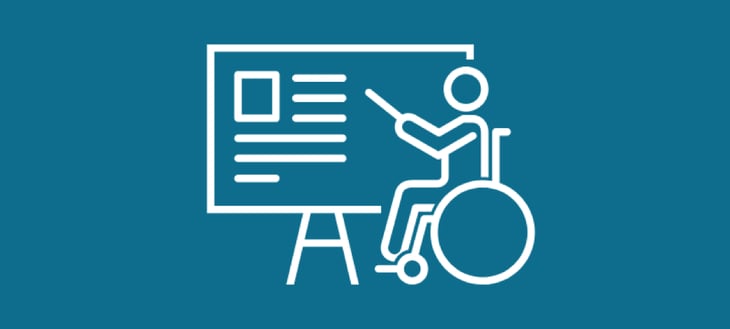 A person in a wheelchair teaching and pointing at information on a board
A person in a wheelchair teaching and pointing at information on a board
The work of being an artist can often feel like striving to accomplish the impossible with few and limited resources. My hope is that the suggestions provided above are not only simple and feasible but that at least some of them can easily be incorporated into your regular event planning workflow.
I also want to recognize that this post is limited in focus, on accessibility for audiences, so keep in mind that other considerations and accommodations would be relevant to fostering accessible collaboration with artists with disabilities and others whose needs that are not typically provided for in the arts. This guidance is tailored for arts organizers like myself who could do more to improve accessibility for audiences in their practices.
And again, this is just a brief list of ways you can welcome more members of your audiences to experience your work, that is in no sense comprehensive. Here are a couple of resources to learn more, in addition to the links included above:
- I relied extensively on Carolyn Lazard’s Accessibility in the Arts: A Promise and a Practice, a print publication distributed to attendees of Common Field’s 2019 Convening, in preparing this blog post. The online version of this guide will be made available at promiseandpractice.art this summer.
- The National Center for College Students with Disabilities’ resource library is an excellent resource for locating reference guides on inclusive event planning.
Join Us: Click here to become a member.
Fractured Atlas on Social: Instagram | Tumblr | Twitter | Facebook
About Arno Mokros
Arno Mokros is a queer writer, print artist, and administrative professional committed to fostering accessibility and inclusion in arts communities. He is co-founding editor of Little Pharma, an intersectional feminist art and literary zine, a dedicated space for creative explorations of mental illness. Prior to joining the Fractured Atlas team, he gained program administration experience at the Social Science Research Council in Brooklyn, NY. He holds a B.A. from Smith College, and completed coursework at the University of Hamburg in Hamburg, Germany.
